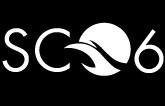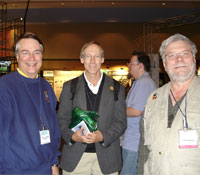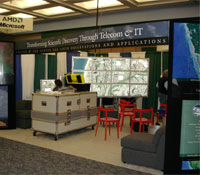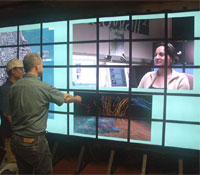Advanced Geo-, Bio-, and Genomics Science Based on OptIPuter Technologies Showcased by Calit2, CEOA, and Partners at SC06
By Stephanie Sides
|
Tampa, FL, November 13-17, 2006 -- Calit2, a UCSD/UCI partnership, and UCSD’s Center for Earth Observations and Applications (CEOA), led by the Scripps Institution of Oceanography, and partners will showcase how advanced applications − from geoscience to bioscience to genomics − are benefiting from OptIPuter technologies at next week’s SC06 (Supercomputing) conference at the Tampa, FL, Convention Center November 13-17. The OptIPuter project is an NSF-funded Information Technology Research grant to principal investigator Larry Smarr that is developing a powerful, distributed cyberinfrastructure to support data-intensive scientific research and collaboration.
“We’re now in the fourth year of our five-year OptIPuter grant,” said Calit2 director Smarr. “The results of our team’s research are now being applied by many of our partners, as will be seen in many exhibits around the SC06 show floor.”
OptIPuter technologies and supported applications will be showcased in:
- the Calit2-CEOA research exhibit #1647 (including real-time collaboration with many other exhibits on the show floor)
- the Apple exhibit (#1834)
- two papers in the technical program
- presentations at the National LambdaRail booth (NLR, #1951).
The Calit2-CEOA exhibit will also participate in NLR’s Treasure Hunt.
|
||||
Exhibit demonstrations, in particular, will highlight the “OptIPortal” – which is the appropriate “termination device” for dedicated 1- or 10-gigabit/s optical light paths. An OptIPortal is a cluster running Rocks/SAGE software, driving tiled displays. SAGE serves as a window manager, enabling users to bring up multiple windows − for streaming media, web browsing, or visualization of large datasets. Rocks is an automated cluster configuration technology developed by OptIPuter partner San Diego Supercomputer Center. SAGE has been developed by OptIPuter partner University of Illinois at Chicago’s Electronic Visualization Laboratory (EVL).
The applications in the Calit2-CEOA exhibit will include “visual-casting” to create a distributed virtual laboratory; collaborative cyberinfrastructure to support multi-scale, multi-modal, multi-site science; real-time data delivery from land and onboard ship; and interactive visualization to aid in the analysis of Earth science, protein structure, and metagenomic data.
SAGE visual-casting will be demonstrated in collaboration with OptIPuter and other research partners on the show floor: Purdue, NBCR/Osaka University, NCHC (Taiwan ), SARA (Amsterdam ), and University of Michigan. EVL and the Chinese Academy of Sciences’ Computer Network Information Center are scheduled to be engaged remotely via the National LambdaRail during the show.
|
A paper on the SAGE architecture entitled “High-Performance Dynamic Graphics Streaming for Scalable Adaptive Graphics Environment,” by Byungil Jeong, et al., will be presented in the Technical Papers part of the program. (Wednesday, 2:30-3:00 PM, room 20-21)
The demonstration featured at the Calit2-CEOA exhibit during the press tour at SC06’s Monday night gala, by Mark Ellisman, will show the use of integrative, collaborative cyberinfrastructure to support multi-site interaction with high-resolution neuroscience datasets and 3-D models of neuronal subcellular structures derived from light microscopy and electron tomography. Ellisman is director of the National Center for Microscopy and Imaging Research (NCMIR) and the Center for Research in Biological Structure, both at UCSD.
This demo will be complemented by a technical presentation titled “Large Image Correction and Warping in a Cluster Environment,” by Vijay S. Kumar, et al., who will discuss efficient execution of a pipeline of data processing operations on very large images obtained from confocal microscopy instruments. (Tuesday, 11:00-11:30 AM, room 18-19)
Presentations by OptIPuter partners in the NLR exhibit (#1951) will include Larry Smarr speaking on “OptIPuter Technologies Enable Genomic and Oceanographic Research” (Tuesday, 3:30 PM), Jason Leigh of EVL speaking about “Global Lambda Visualization Facility and SAGE Visual-Casting” (Tuesday, 4:30 PM), and Maxine Brown of EVL speaking on “TransLight and GLIF.” (Wednesday, 4:30 PM)
About OptIPuter
OptIPuter, one of the largest Information Technology Research grants ever awarded by the National Science Foundation, is enabling collaborating scientists to interactively explore massive amounts of previously uncorrelated data by developing a new network-centric cyberinfrastructure to support a range of e-science shared information technology facilities. It is a tightly integrated cluster of computational, storage, and visualization resources, linked over parallel, dedicated optical networks across campus, metro, national, and international scales. The OptIPuter runs over multi-1 to 10-Gbps lambdas, with advanced middleware and network management tools and techniques to optimize transmissions so distance-dependent delays are the only major variable. www.optiputer.net
About Calit2
Calit2 is inventing the collaborative research environment for the digital future. To that end, it conducts research on the future of telecommunications and information technology and how these technologies with transform a range of applications important to the economy and quality of life. The institute teams UCSD and UC Irvine faculty, students, and research professionals with leading California telecommunications, computer, software, and applications companies to conduct studies in “living laboratories” to investigate how the future Internet will accelerate advances in environmental science, civil infrastructure, intelligent transportation and telematics, genomic medicine, new media arts, and educational practices. www.calit2.net
About the Center for Earth Observations and Applications
In 2005 the University of California, San Diego, established the Center for Earth Observations and Applications (CEOA). Led by Scripps Institution of Oceanography, CEOA provides an integrating vision for our work across the spectrum of natural, physical, and social sciences, engineering, and information technology related to Earth observations and applications. ceoa.ucsd.edu
About the Electronic Visualization Laboratory
EVL at the University of Illinois at Chicago is a graduate research laboratory specializing in the design and development of high-resolution visualization and virtual-reality display systems, collaboration software for use on multi-gigabit networks, and advanced networking infrastructure. EVL is a joint effort of UIC’s College of Engineering and School of Art and Design, and represents the oldest formal collaboration between engineering and art in the country offering graduate MS, PhD and MFA degrees. EVL has received worldwide recognition for developing the original CAVE® and ImmersaDesk® virtual-reality systems; and most recently the 105-Megapixel LambdaVision tiled display and Varrier autostereoscopic display. EVL is a founding member of StarLight and the Global Lambda Integrated Facility (GLIF), and, with Calit2 at UCSD, is a leading institution working on the NSF-funded OptIPuter project. www.evl.uic.edu
About the National Center for Microscopy and Imaging Research
NCMIR at the University of California, San Diego, develops state-of-the-art 3-D imaging and analysis technologies to help biomedical researchers understand biological structure and function relationships in cells and tissues in the dimensional range between 5 nm3 and 50 µm3. ncmir.ucsd.edu
About the National LambdaRail
NLR is advancing the research, clinical, and educational goals of members and other institutions by establishing and maintaining a unique nationwide network infrastructure that is owned and controlled by the U.S. research community. Ownership of the underlying optical infrastructure ensures the research community unprecedented control and flexibility in meeting the requirements of the most advanced network applications and providing the resources demanded by cutting-edge network research. www.nlr.net
About the San Diego Supercomputer Center
Founded in 1985, SDSC enables international science and engineering discoveries through advances in computational science and high performance computing. Continuing this legacy into the era of cyberinfrastructure, SDSC is a strategic resource to science, industry and academia, offering leadership in the areas of data management, grid computing, bioinformatics, geoinformatics, high-end computing as well as other science and engineering disciplines. The mission of SDSC is to extend the reach of scientific accomplishments by providing tools such as high-performance hardware technologies, integrative software technologies and deep interdisciplinary expertise, to the community. www.sdsc.edu
Media Contacts
Calit2: Stephanie Sides, ssides@ucsd.edu, 858-534-5131
CEOA: Mario Aguilera, maguilera@ucsd.edu, 858-534-3626
EVL and the OptIPuter: Maxine Brown, maxine@evl.uic.edu, 312-996-3002
NCMIR: Skip Cynar, scynar@ncmir.ucsd.edu, 858-822-0738
NLR: Susan Estrada, sestrada@aldea.com, 760-510-8406
SDSC: Paul Mueller, pmueller@ucsd.edu, 858-534-8564





